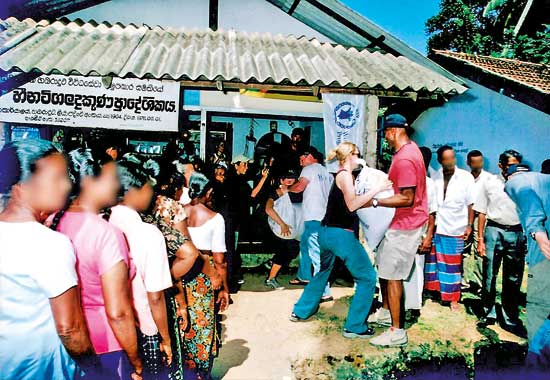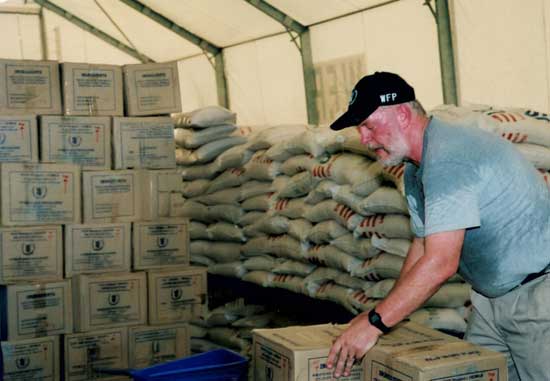The food kept rolling in: How WFP worked like there was no tomorrow
View(s):The waves hit the island of Sri Lanka in a wide semi-circle, slamming against all three of its coastlines, tearing into villages, wiping away roads and houses. In the east, the towns of Batticaloa and Trincomalee were badly flooded, and in the Ampara district, whole communities were washed away. In the South, a passenger train along the coast outside the town of Galle was hit, killing over 800 people on board.
In just a matter of minutes, the tsunami had killed tens of thousands of people, and left hundreds of thousands without homes.
The initial estimate by midday on December 26, 2004, was that 400,000 people across the country might need food aid, according to Mohamed Haffee, one of the World Food Programme’s (WFP) Logistics Officers in Sri Lanka at the time. “But an hour later the figure was 500,000,” he said. “And by the next day it was 700,000.”

Tsunami-affected communities await their food rations
As the caseload mounted, something else became clear to Haffee; WFP did not have nearly enough food in stock to feed that many people. By this point, the government had provided a figure on how many people required emergency assistance: 749,000. Haffee did a quick calculation in his head. They were short of 4,000 tonnes of food. “I was managing the food stocks, and I knew we didn’t have an emergency reserve,” he said. “We were facing a major shortage of food.”
Very quickly, the Australian and Japanese governments agreed to release rice and other food that they had donated to WFP, and that WFP had in stock for its long-term programmes, for the immediate emergency. WFP’s Logistics and Procurement teams worked around the clock to get what food WFP had onto trucks and to find new local sources of food.

WFP former Country Director Jeff Taft-Dick managing the food distribution
For the first few days, WFP made do with existing stocks and purchased everything it could find locally. WFP planes flew in with vitamin-fortified biscuits for children. The immediate food crisis came to an end in mid-January, when the US Agency for International Development (USAID) diverted three ships carrying 2,450 metric tonnes of rice to Sri Lanka. The food was finally in place. However, WFP faced a fresh challenge: how to get that food to those who most needed it.
There was an acute shortage of trucks in Sri Lanka in the immediate aftermath of the tsunami. WFP had only a few trucks of its own, private trucking firms were hugely overbooked, and the government was over-stretched. Trucks – many of them – had to be found.
A call from Unilever Sri Lanka, the national branch of the global consumer products firm, turned things around. Many of Unilever’s local agents, sellers who were in touch with local conditions, had been telling the national office that they wanted to help out the tsunami-hit areas. Three days after the tsunami, Unilever Sri Lanka’s Director gave WFP’s Country Director a call.
The result: Unilever put its entire national distribution system at WFP’s disposal and ran two trains full of WFP food to Batticaloa and Trincomalee. At the same time, WFP flew in eleven trucks from the Asia Emergency Response Facility in Phnom Penh – a special WFP operation that provides supplies for emer-gencies in Asia. WFP’s primary global logistics partner, TNT, also helped out, and TNT trucks were soon on the road in Sri Lanka, carrying WFP food every day.
By early January, the global resources of WFP were being put towards tsunami relief. Dozens of WFP staff from all over the world were sent to Colombo. A country office that had had six international staff now had 73. “It was crazy,” said WFP’s former Deputy Country Director (late) Jean-Yves Lequime. “I remember starting at 6 a.m. and ending very late. I remember having to stop people in the halls and ask them who they were and what they were doing. And that was life at the time.”
But the ceaseless work paid off. On January 9, 2005, twelve days after the tsunami, WFP announced that it had dispatched 5,000 metric tonnes of food in Sri Lanka, enough to feed 750,000 people – all those who were thought to have been affected by the tsunami. “We all felt driven,” said Lequime. “You can’t say ‘I’ll do it tomorrow’ in such a situation. You know you have to do it today.”
WFP’s emergency operation continued until December 2005, reaching over 900,000 tsunami-affected people with food assistance. This was augmented with a recovery programme in the following years to support communities affected by the civil conflict and tsunami.
In 2016, WFP took on the role to assist the Government in enhancing national emergency preparedness capacities. WFP continues to work with national and sub-national authorities to reduce disaster risks, as part of broader efforts to improve food and nutrition security in the country.
(Adapted from ‘The United Nations World Food Programme Indian Ocean Tsunami Emergency Operation’ published in February 2006)
Searching for an ideal partner? Find your soul mate on Hitad.lk, Sri Lanka's favourite marriage proposals page. With Hitad.lk matrimonial advertisements you have access to thousands of ads from potential suitors who are looking for someone just like you.


